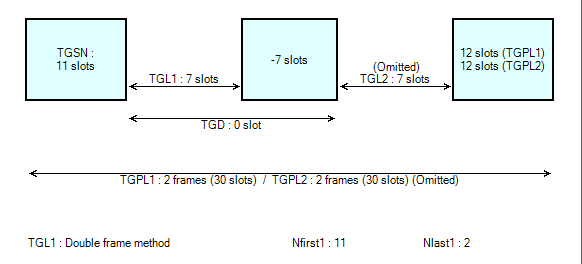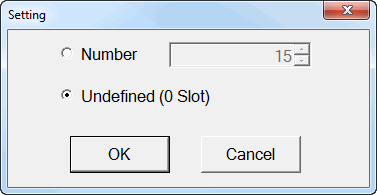Compressed Mode - TGPSn
These settings control the real-time transmission gap pattern sequence identifier (TGPSI) functionality. The current settings for the TGPSn selected are displayed below the parameter settings in the  transmission gap graphic. The transmission gap graphic updates whenever a change is made to the related parameters in the current TGPS tab.
transmission gap graphic. The transmission gap graphic updates whenever a change is made to the related parameters in the current TGPS tab.
There are up to 6 TGPS.
|
TGPSI |
|---|
Compressed Mode - TGPSn Configuration Summary Table
This section defines the Settings Current and Apply Needed buttons. Only one button is available at any time. These buttons are available in all of the W-CDMA Uplink's tree nodes.
1. General
TGPS
Choice: Active | Inactive
Default: Inactive
Sets the Compressed Mode state.
If the parameter set by the following command is changed while the signal is active, Play must be executed for the change to occur.
[:SOURce]:RADio:WCDMa:TGPP[:BBG]:ULINk:TGAP:PSI[1]|2|3|4|5|6:PS ACTive|INACtive
[:SOURce]:RADio:WCDMa:TGPP[:BBG]:ULINk:TGAP:PSI[1]|2|3|4|5|6:PS?
TGCFN
Range: 0 to 255
Default: 0
Sets the connection frame number (CFN) of the first radio frame of the first pattern within the transmission gap pattern.
[:SOURce]:RADio:WCDMa:TGPP[:BBG]:ULINk:TGAP:PSI[1]|2|3|4|5|6:CFN <val>
[:SOURce]:RADio:WCDMa:TGPP[:BBG]:ULINk:TGAP:PSI[1]|2|3|4|5|6:CFN?
TGPRC
Range: 0 (Infinity) to 511
Default: 0 (Infinity)
Sets the number of transmission gap patterns in the transmission gap pattern sequence. Set TGPRC to 0 for infinite pattern repetition.
For the command/query, if <val> = 0, then INFinity is returned by the SCPI query.
[:SOURce]:RADio:WCDMa:TGPP[:BBG]:ULINk:TGAP:PSI[1]|2|3|4|5|6:PRC <val>|INFinity
[:SOURce]:RADio:WCDMa:TGPP[:BBG]:ULINk:TGAP:PSI[1]|2|3|4|5|6:PRC?
TGSN
Range: 0 to 14 (Slot)
Default: 11 (Slots)
Sets the transmission gap starting slot number (TGSN). TGSN is the slot number of the first transmission gap slot in the first radio frame of the transmission gap pattern
[:SOURce]:RADio:WCDMa:TGPP[:BBG]:ULINk:TGAP:PSI[1]|2|3|4|5|6:SN <val>
[:SOURce]:RADio:WCDMa:TGPP[:BBG]:ULINk:TGAP:PSI[1]|2|3|4|5|6:SN?
TGL1
Choice: 3 | 4 | 5 | 7 | 10 | 14 (Slot)
Default: 7 Slots
Sets the TGL1 value, expressed in number of slots.
[:SOURce]:RADio:WCDMa:TGPP[:BBG]:ULINk:TGAP:PSI[1]|2|3|4|5|6:L1 3|4|5|7|10|14
[:SOURce]:RADio:WCDMa:TGPP[:BBG]:ULINk:TGAP:PSI[1]|2|3|4|5|6:L1?
TGL2
Choice: Omitted (TGL2 = TGL1) | 3 | 4 | 5 | 7 | 10 | 14 (Slot)
Default: Omitted
Sets the TGL2 value, expressed in number of slots. If the Omitted is selected, TGL2 = TGL1.
For the command/query, if <val> = 0, then UNDefined is returned by the SCPI query.
[:SOURce]:RADio:WCDMa:TGPP[:BBG]:ULINk:TGAP:PSI[1]|2|3|4|5|6:L2 3|4|5|7|10|14|OMITted
[:SOURce]:RADio:WCDMa:TGPP[:BBG]:ULINk:TGAP:PSI[1]|2|3|4|5|6:L2?
TGD
Range: 0 (Undefined), 15 to 269 (Slot)
Default: 0 Slot
Sets the transmission gap start distance (TGD), which is the duration between the starting slots of two consecutive transmission gaps within a transmission gap pattern, expressed in number of slots. If TGD = 0, then only one transmission gap is available in the transmission gap pattern.
Edit the transmission gap distance (TGD) of the uplink Compressed Mode by clicking on the cell. Then click on the dialog box icon  to launch the
to launch the  Setting dialog box.
Setting dialog box.
For the command/query, if <val> = 0, then UNDefined is returned by the SCPI query.
[:SOURce]:RADio:WCDMa:TGPP[:BBG]:ULINk:TGAP:PSI[1]|2|3|4|5|6:D <val>|UNDefined
[:SOURce]:RADio:WCDMa:TGPP[:BBG]:ULINk:TGAP:PSI[1]|2|3|4|5|6:D?
TGPL1
Range: 1 to 144 (Frame)
Default: 2 Frames
Sets the transmission gap pattern length (TGPL1), expressed in number of frames.
[:SOURce]:RADio:WCDMa:TGPP[:BBG]:ULINk:TGAP:PSI[1]|2|3|4|5|6:PL1 <val>
[:SOURce]:RADio:WCDMa:TGPP[:BBG]:ULINk:TGAP:PSI[1]|2|3|4|5|6:PL1?
Method
Choice: SF/2 | Higher Layer
Default: SF/2
Sets the DPCH compression mode method.
|
SF/2 |
This choice selects a compressed mode method that reduced the spread factor (SF) by 2. This is done by increasing the data rate by reducing the spreading factor in half. When the dedicated physical data channel’s (DPDCH) symbol rate is 960 kbps, the frame is not compressed because it uses the lowest SF value and it cannot be reduced. |
|
Higher Layer |
This choice selects a higher layer scheduling method. The emulated higher layer scheduling method mode keeps the same physical layer data rate even when a transmission gap is created. |
[:SOURce]:RADio:WCDMa:TGPP[:BBG]:ULINk:TGAP:PSI[1]|2|3|4|5|6:CMMethod SF2|HIGHer
[:SOURce]:RADio:WCDMa:TGPP[:BBG]:ULINk:TGAP:PSI[1]|2|3|4|5|6:CMMethod?





